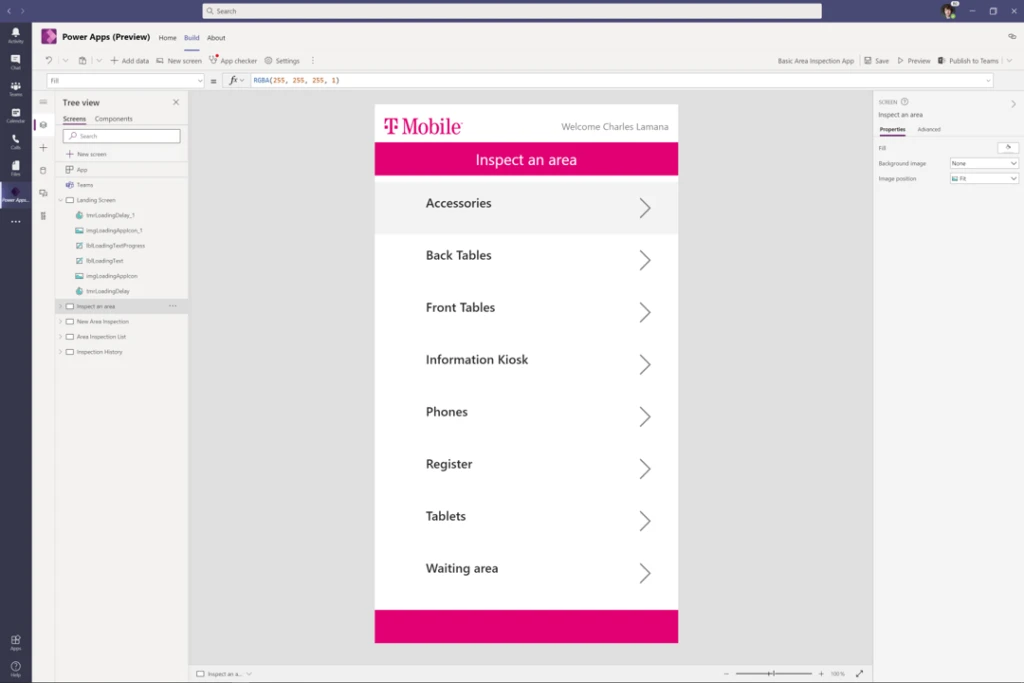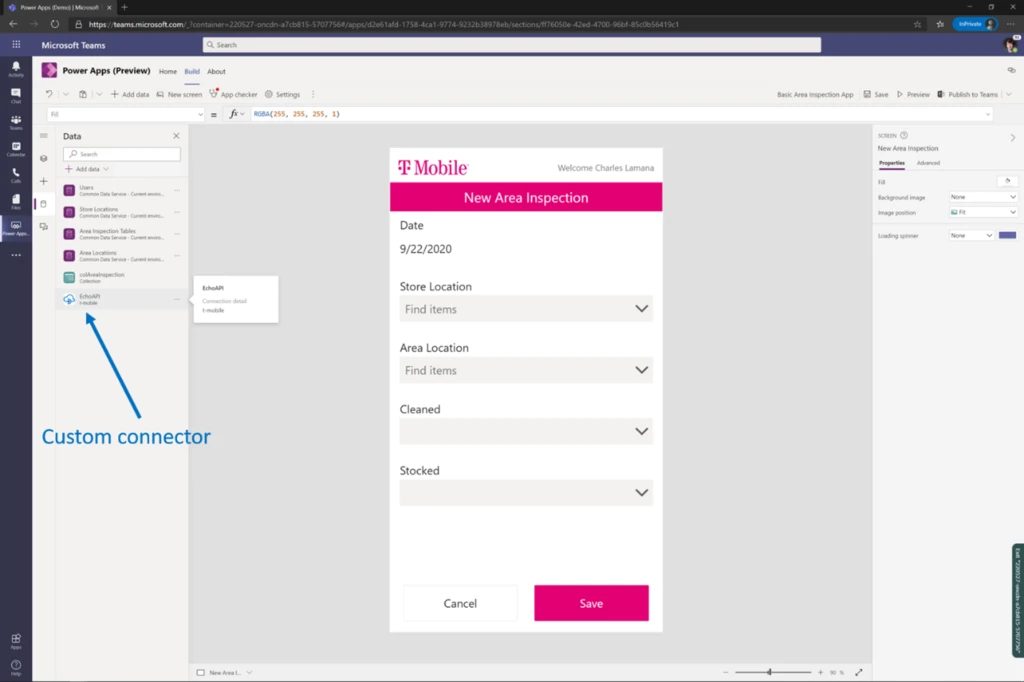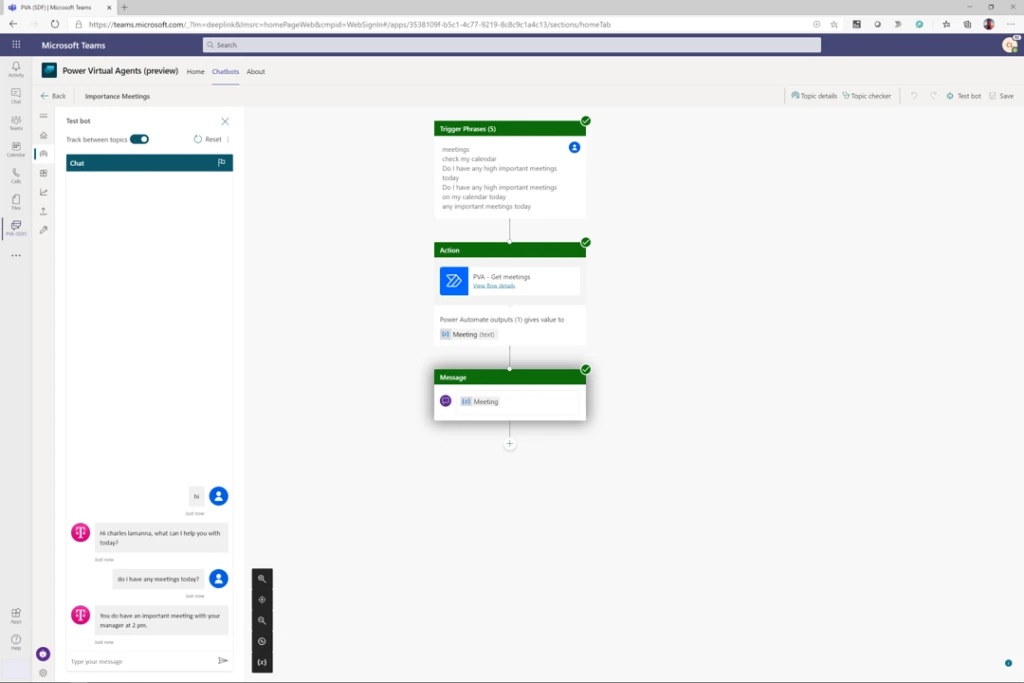T-Mobile is the second largest wireless provider in the United States with over 98 million customers and the only nationwide 5G network. T-Mobile wants to manage costs but also accelerate application development with services enabling users to create their own solutions to business challenges. To this end, T-Mobile has been using Microsoft Power Apps, Microsoft Power Automate, and Microsoft Power BI to address business needs. Now, T-Mobile is excited to leverage the next wave of Microsoft Power Platform enhancements that were announced at Microsoft Ignite and our Microsoft Business Applications Virtual Launch event:
- Rapid app development with deeper integration between Microsoft Teams and Power Apps
- Better collaboration between pro and citizen developers with deeper integration between Microsoft Azure and Power Platform
- Expanded automation capabilities with the new Microsoft Power Automate Desktop
- Easy-to-build chatbots with deeper integration between Teams and Power Virtual Agents
Let’s look at how T-Mobile intends to use these great new features.
Connecting productivity with app development and the intelligence of Azure
Brian Hodel is a Senior Developer for Power Platform who helped spearhead T-Mobile’s Power Platform adoption. He was excited to hear about the launch of Dataverse which connects Teams to a powerful low code data platform with relational data storage, rich data types, enterprise grade governance, and one-click solution deployment. Dataverse enables everyone to easily build and deploy apps and intelligent chatbots in Teams with Power Apps, Power Automate, and Power Virtual Agents. Brian used Dataverse to create an Area Inspection app used for inspections in different parts of T-Mobile stores. Dataverse comes with templates for frequent use cases, such as Area Inspections, to accelerate app development. Brian and his team built off the Area Inspection template and made simple modifications to meet their needs and match T-Mobile branding (figure 1).

T-Mobile also created an internal app called “Orbit,” using Power Apps and Common Data Service, for project planning and managing go-to-market activities. The Orbit app also required a custom connector for advanced search querying, so Brian used his pro-coding skills and wrote a custom API in Visual Studio Code and published it to Microsoft Azure API Management. With Azure API Management, you can create, design, test, and quickly publish APIs to Power Platform to enable easy discovery and consumption. Once exported as a custom connector to Power Platform, the APIs are accessible for anyone to use. In the case of “Orbit” and other apps, T-Mobile believes it’s important for pro developers to collaborate with citizen developers.
Another exciting announcement is that any Azure API Management backed connector can now surface inside Teams with no additional licensing costs. This feature is available for preview starting October 2020 and empowers a massive number of low code developers to take advantage of APIs and custom connectors built by professional developers. T-Mobile was able to use Azure API Management to surface the custom connector in Dataverse for use in their apps (figure 2).

Addressing modern challenges with Power Automate Desktop
T-Mobile found another impactful use for Power Platform stemming from its recent merger with Sprint. Integrating systems quickly is paramount to the success of many mergers. In the case of T-Mobile, they were looking for a solution which could easily automate data transfer between the Orbit app, which manages and catalogues T-Mobile’s internal initiatives, and the Sprint G2M web app which tracks project execution. The G2M app does not have an API, so T-Mobile was looking for a Robotic Process Automation (RPA) solution to integrate with the G2M system via its user interface. Power Automate was the perfect service for T-Mobile as it enables automation across the modern T-Mobile Orbit app and the older G2M Sprint app (figure 3).

The new Power Automate Desktop enhances the RPA capabilities offered with Power Automate, combining the UI flows released earlier this year with the WinAutomation capabilities that we added through our acquisition of Softomotive. Power Automate Desktop includes a more intuitive recorder for Firefox, Internet Explorer, Microsoft Edge, and Google Chrome. Power Automate Desktop also expands desktop recording capabilities to include Citrix, SAP, Java, AS400, and a variety of other legacy applications on top of Win32.
With Power Automate Desktop, T-Mobile was able to create a process automation which updates the Sprint G2M app anytime a new initiative is created in the Orbit Power App. This remarkable automation is done using a few connectors and the new Power Automate Desktop RPA enabling automation across modern API-based apps and non-API based apps.
Enabling pro and citizen developers to create chatbots to enhance the way we work
T-Mobile is also creating chatbots using Power Virtual Agents to unlock a powerful new way to work and interact. Power Virtual Agents is now available as part of Dataverse, making chatbots accessible and easy to design for every user of Teams. As a result, T-Mobile was able to create a digital assistant chatbot entirely in Teams in the Power Virtual Agents canvas (figure 4). This bot helps users keep track of important meetings, pending approvals, and other daily tasks.

Take a moment and check out today’s Microsoft Business Applications Launch Event where I demo how T-Mobile is using Power Platform including app development, RPA, and chatbots.
Join our community and get started today
Join the growing Power Platform Community so you can get the latest updates, join discussions, and get ideas on how Power Platform can help your organization. Also, you can learn how the products work from these learning modules available at Microsoft Learn.
Check out Power Platform sessions from Microsoft Ignite
- Build Agile Business Processes with Power Apps.
- Microsoft Power Platform: Fill the App Gap and Supercharge Organizational Agility.
- Automate your desktop with Power Automate.
- Build intelligent bots for your employees using Power Virtual Agents and Teams.
- Building Bots with Power Virtual Agents and extending them with Microsoft Bot Framework.
Also, check out these other great Microsoft Mechanics videos featuring Power Platform:
- How to use the Microsoft Power Platform | Getting Started.
- Inside the Microsoft Power Platform | Power Apps, Power Automate, Power BI and more.
- Power BI & Azure – Self-Service Report Creation | Humana’s Practical Use Case.
- Power Platform Admin Center | Unified IT Management Experience.
- Power Apps | New Capabilities Building Zero-To-Low-Code Apps.
- Power BI – AI and Q&A updates, decomposition tree, and data prep.
- Robotic Process Automation with Microsoft Power Automate, UI flows and AI Builder.
- How to Build (automated, no code) Chatbots with Microsoft Power Virtual Agents.




